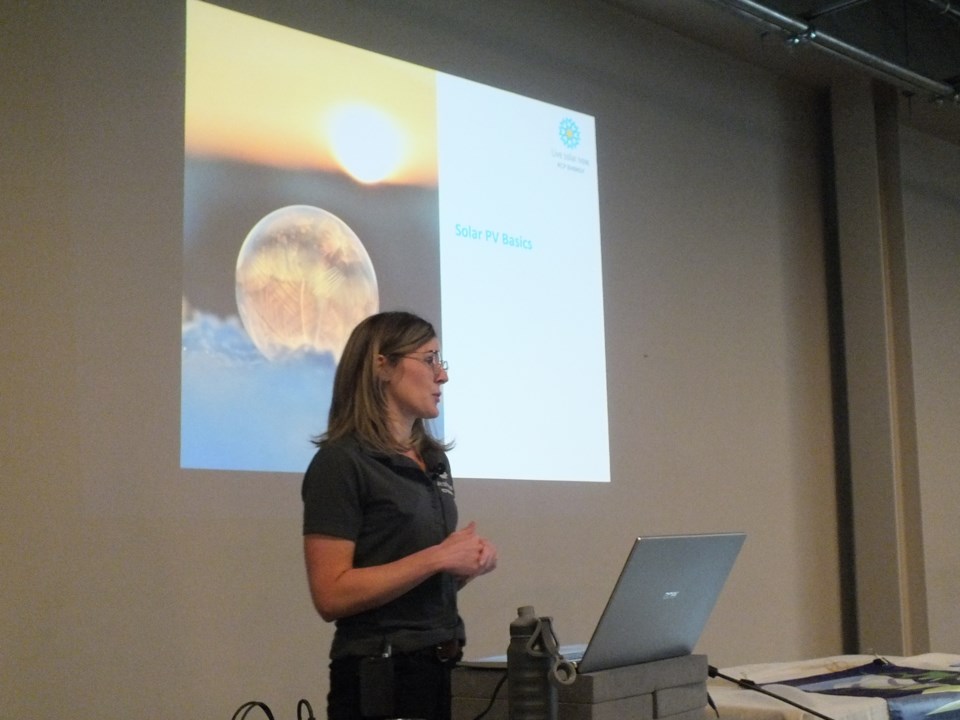More than 70 eager-to-learn Cochranites came out last Saturday to hear about residential solar power at a presentation sponsored by the Cochrane Ecological Action Committee (CEAC).
In a sort of ‘solar power 101’ format, guest speaker Valerie Atkinson of KCP Energy outlined what is involved in residential solar energy on Jan. 14 at the SLS Centre, answering some frequently-asked questions as she went along.
KCP, she said, has been doing solar energy since “way before it was cool.”
Organizers were pleased with the turnout, and although they asked the audience to hold off on questions until after the presentation, Atkinson had to field queries from attendees who seemed unable to wait.
Their enthusiasm perhaps spoke to a willingness among some to at least consider embracing a technology that may seem complex, expensive, and a bit daunting at first.
The first step in the process would be to design a system for the home, including an analysis of past power usage and a discussion of needs and goals. Atkinson suggested getting multiple quotes.
The design stage is not as simple as installing as many panels as your roof can support.
In Alberta, residents are first required to sign a micro-generation agreement with the wire owners. In Cochrane, that’s FortisAlberta, and there are rules that residences need to follow if they plan on embracing solar power.
For instance, the amount of energy homeowners are allowed to generate has to be equivalent to annual consumption.
“Unfortunately, if you have the most beautiful south-facing roof in the world – perfect for solar – it doesn’t mean you can cover the entire area with panels, because we have to make sure we’re looking at your consumption on an annual basis, and design according to that, because you are a micro-generator,” Atkinson explained.
Atkinson said her company makes a 3D design of the house and also assesses the roof to make sure it’s suitable for solar.
Rural residents may want to consider a ground-mounted system, as space isn’t as limited as it may be for urban houses.
Showing a slide of a commercial project in Canmore, Atkinson illustrated one of the differences between pitched roofs and flat roofs.
“The two main concerns for a flat roof project is to make sure it’s not going to blow off the roof, and it’s not going to fall through the roof,” she said.
Micro-inverters, which convert solar power to usable energy, are installed behind the panels on the roof.
A bi-directional meter will be installed where the existing electrical meter is, which will be used to measure what the net import (the charge) and net export (the credit) will be.
When homeowners use power from the grid, they are paying a fee per kilowatt-hour (kWh) as well as other costs such as transmission fees. When they’re using self-generated power from their home system, it doesn’t include other fees, so is much cheaper.
That fact, Atkinson suggested, is a reason why those thinking of transitioning to solar residential power should consider the importance of modifying their behaviour, as users will want to take advantage of all the cost-savings possible by doing things like scheduling certain activities for specific times of day.
“When the solar system is producing during the day, that’s when you want to be running appliances, doing the laundry, washing the dishes, things like that,” Atkinson said.
Setting timers during the day is also a good option for those who aren’t home to turn things on and off.
Ears perked up in the crowd when Atkinson moved to the ‘Cost’ slide in her presentation.
An average residential system measured at nine kilowatts (kW) direct current would require about 23 panels, costing approximately $22,500 before any applicable grants, according to Atkinson’s review of her company’s installs over the past year.
The current federal grant available for new solar installations is the NRCAN Greener Homes Grant (from Natural Resources Canada) which provides up to $5,000.
There is also a loan available through the same program for up to $40,000, which is interest-free for a 10-year repayment period.
There are no provincial or municipal grants for solar power currently available.
Atkinson said the average payback period for a residential solar energy package is around 10 years, noting that homeowners can also count on a return on their investment when and if they put their homes on the market.
She said solar panels are largely hail-resistant, as they are made with tempered glass and go through rigorous testing.
“As solar panels are typically mounted at an angle, they naturally deflect the path of the hail, which also helps with the result of the impact,” she said.
“We often have to remove and reinstall healthy solar systems on roofs that need to be re-shingled due to hail damage.”
For the environmentalists in the crowd, Atkinson said installing a solar system works out to the equivalent of planting 5,542 trees, or removing two vehicles from the road for a year.
Demand for solar installations is surging across Canada, according to the Canadian Renewable Energy Association, an industry group that represents 300 companies involved in wind, solar and energy storage.
Last week, the German company RCT Solutions met with cabinet ministers in Manitoba, where they’ve announced they want to build North America’s largest solar panel manufacturing operation as soon as possible.
If it passes the environmental impact reviews, RCT’s proposed solar panel plant would be a $3-billion investment eventually requiring a workforce of 8,000 people. They’re looking to produce about 30 million photovoltaic panels.
RCT Solutions has built one of the largest solar panel plants in the world in Turkey and is in the process of building one five times larger in India – roughly the same size as the proposed plant in Manitoba.




